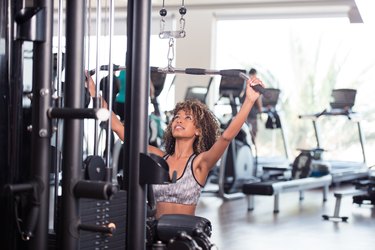
The straight-arm pulldown isn't seen that often in the gym, but those in the know rely on it to add back width. It is an isolation movement, meaning that only one joint is moving, and while it works several of the same major muscle groups as the pullup, it removes biceps from the equation. This allows the muscles of the back to be worked intensely, as bicep endurance is often the limiting muscle factor during a back workout.
Tip
Perform straight-arm pulldowns to strengthen your lats, teres major and triceps. Your abs also get in on the action by stabilizing your body while your arms move.
Video of the Day
Use Proper Form
When performed with proper form, the straight-arm pulldown exercise uses muscles in your back and shoulders, while engaging your abdominals as stabilizers.
Video of the Day
To perform the straight-arm pulldown, attach a straight bar to a high pulley machine. Face the machine and hold the bar with an overhand grip. Position one foot slightly forward of the other, flex your knees and bend forward from the waist. Your arms should be extended — but not locked — and your hands slightly higher than your head in the starting position. Keep your arms fairly straight as you pull the bar down just short of your thighs. Return slowly to the starting position. You can also use rope handles, with your palms facing each other.
Read more: Alternative to Lat Pulldowns
1. Latissimus Dorsi
The latissimus dorsi are the large, wing-like muscles that attach to the body along the mid-to-lower back, and on the arm at the upper humerus. They are responsible for extending and rotating the upper arms in toward your body. The straight-arm pulldown is one of the best lat-targeting exercises available. Even if you're a champ at pullups, the straight-arm pulldown may make your lats sore the next day.
Read more: Biceps Lat Pulldown Exercises
2. Teres Major
The teres major sits just above the lats, attaching at the scapula and the upper humerus. Its primary function in weight lifting is to aid the lats in drawing the arm down and back. When built up by exercises such as the straight-arm pulldown, the teres major adds width to the upper back.
3. Triceps
The triceps brachii are composed of three heads each: lateral, medial and long. They sit at the backs of the arms, attaching across the elbows, and are primarily responsible for straightening the arm at the elbow. During a straight-arm pulldown, the triceps work isometrically to hold the arms straight. At the shoulder, the long head of the triceps attaches to the scapula. It aids the latissimus dorsi and teres major in extending the arm, making it an active participant during straight-arm pulldowns.
Read more: Ab Pain from Pullups
4. Abdominal Muscles
Like the triceps pushdown, the straight-arm pulldown requires you to activate your abdominal muscles strongly to prevent the back from hyperextending. This is one of those rare exercises during which, like an abdominal exercise, slightly rounding the back actually relieves the strain on the lower back. The heavier the weight you use, the more intense the crunching action will be in the rectus abdominis and the external obliques on each side of your abdomen.